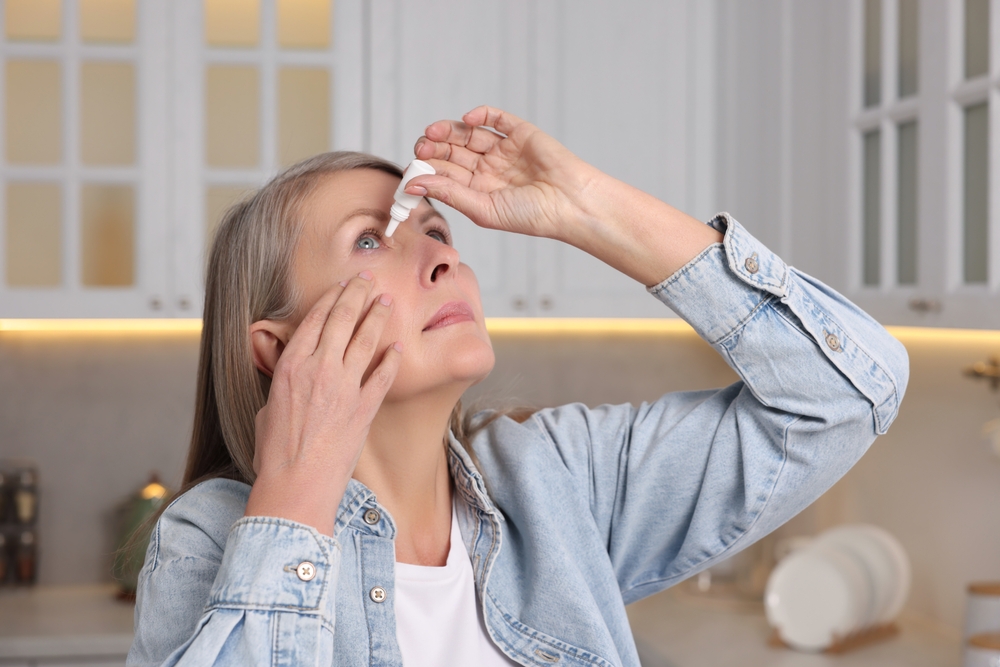Posted by: Associates in Ophthalmology (NJ) in Eye Health

Persistent dry eye symptoms can be challenging to deal with. They can affect your vision, comfort, and ability to do things like wearing contact lenses.
The good news is that there are many treatments available for dry eye. These include both at-home remedies and more advanced treatments from your eye doctor.
Keep reading to learn more about how to manage dry eye symptoms.
What is Dry Eye?
Dry eye, also known as dry eye syndrome, is a common eye condition where your eyes cannot create enough tears to stay properly lubricated, or the tears they make are poor in quality and evaporate too quickly. This can occur when your tear film is missing one of its vital components to remain stable: oil, water, and mucus.
Although almost everyone experiences dry eyes occasionally, dry eye syndrome is when persistent symptoms do not go away on their own.
What are the Symptoms of Dry Eye?
Dry eye has many symptoms besides dry eyes, including:
- Redness and irritation
- Stinging or burning sensations
- Feeling like there’s something in your eye
- Intolerance to contact lenses
- Excess tears and mucus in and around the eyes
- Eye fatigue
- Heightened sensitivity to light
- Blurred vision
If you think you may have dry eye, you should schedule an eye exam with your eye doctor at Associates in Ophthalmology. While these symptoms are often indicators of dry eye, they are also associated with other conditions, and it’s important to ensure you are correctly diagnosed.
Can You Manage Dry Eye Symptoms at Home?
Many patients with mild dry eye can manage their symptoms at home through various practices and lifestyle changes, including:
Warm Compresses
A warm compress can help reduce inflammation and release blockages in the meibomian glands, allowing your tear film to build back up. You can do this by laying a warm, damp washcloth over your closed eyelids for about ten minutes at a time.
Limiting Screen Time
Looking at screens for long periods can decrease your blink rate, reducing the amount of tears your eyes are producing. Limiting your screen time can help, as can following the 20-20-20 rule.
The 20-20-20 rule involves looking away from your screen at an object 20 feet away for 20 seconds every 20 minutes. This is especially helpful if you work on a computer all day.
Wearing Less Eye Makeup
Wearing eye makeup such as eyeliner and mascara can block your meibomian glands, preventing your tear film from getting the oils it needs to lubricate your eyes. You can wear it less frequently to see if it improves your symptoms.
Using a Humidifier
Dry air can increase dry eye symptoms, especially during the winter. Using a humidifier in the rooms you spend the most time in can help reduce your symptoms.
Dietary Changes
Drinking more water, especially during the hot and humid summer months, can help your whole body stay hydrated, including your eyes. Foods high in omega-3 fatty acids may also alleviate dry eye symptoms by improving meibomian gland function.
Fish, walnuts, chia seeds, and flaxseed are all great sources of omega-3 fatty acids, but you can also get them from omega-3 fatty acid supplements.
Artificial Tears
Artificial tears are over-the-counter eye drops that temporarily relieve dry eye symptoms. Eye doctors often recommend them in conjunction with other treatments as well.
What Treatments Are Available for Dry Eye?
If your dry eye isn’t responding to at-home treatment, your eye doctor may recommend further treatment. Associates in Ophthalmology offers prescription medications, punctal plugs, and LipiFlow.
We also feature iLux, a state-of-the-art dry eye treatment that uses gentle heat and compression therapy to release blockages in the meibomian glands. This can help restore proper tear film function and bring you the relief you’ve been looking for.
Are you interested in learning more about how to manage dry eye symptoms? Schedule an appointment at Associates in Ophthalmology in Livingston, NJ, today!

